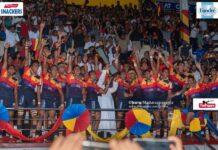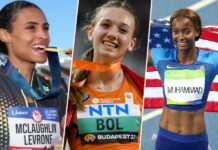Boxing being a man to man game, became immensely popular overnight and drew not only huge crowds as spectators but also a considerable number of eager competitors- some of the local outstanding boxers were Bombardier AB Henricus , Gunners LV Jayaweera and ADV Perera all from Ceylon Garrison Artillery and petty officer Albert Perera and Able seaman K Edwin of the Ceylon Royal Volunteer Navy.
Game introduced by the British –Since the beginning of the 20th Century British Armed forces were in occupation at various parts of the County, then called Ceylon. Royal Naval ships were anchored inside and outside our major harbors at Trincomalee, Colombo and Galle. The Royal Air Force had camps beside the air runaways at Katunayake, China – Bay, Koggala and Katukurunda. They even strengthened their forces by recruiting lot of Ceylonese. In order to maintain high spirits and keep the fighting men healthy and happy the administrators introduced many games such as Athletics, Boxing , Cricket, Soccer and Rugby football – There were many boxing tournaments among the armed forces and in order to conduct them they formed an Association that consisted of representatives from all 3 Armed forces. This first local Association was named as the ‘’United Services boxing Association of Ceylon (USBAC).
Boxing training outside the forces begins
The first Ceylonese to learn the modern amateur boxing was late Mr Donald Obeysekara, who gathered this skill and knowledge while studying as a freshman at Cambridge University in 1888. On his return to Ceylon, he was appointed as a member of the USBAC. Many, mostly British, helped to popularize this sport by commencing practices during the second decade of the 20th Century around 1912. In 1913 Mr CG Pigford of Police along with Mr L Mac D Robison taught boxing at old Police training School at Thimbirigasyaya (presently the Police Field Force HQ ) Mr Donald Obesekara at his old school Royal College, Mr AB Henricus of Army at Wesley College, Mr RV Routledage and Sgt Major Jobson at Trinity College Kandy and Mr Johan Gaye at St Anthony’s College Kandy.
Inter School Championship beings
In 1914 the British Tea Planter Mr SC Trail who fore saw that the future of Ceylon’s boxing would prevail in the hands of school boys, obtained the permission of the Colonial Secretary then (later the Governor) Sir R Edward Stubbs to award a challenge shield in his name annually at an Inter School Championship Boxing Tournament and requested the USBAC to organize and run the tournament. It originated in 1914 and this year it will be held for the 89th time. The Schools Boxing Association consisting of school masters took over from USBAC in 1935 they run it now over 50 schools complete now.
Police Brigade Commences training in 1914
Under the Police Department a Police Brigade was formed and they started training since 1914. This consisted of young schoolboys who would assist local Police in their affairs. Sergeant ES Salladori who was a National Champion from 1926 to 1934 was in charge of training the Brigade boys.
Boxing becomes a playground movement in 1917
The YMCA Central physical Director Mr R Cammack who was from USA introduced boxing as a playground movement to Colombo playgrounds under municipality in 1917. Annual Inter playground Contests were held where around 70 bouts were held.
Scouts take up to Boxing in 1917
During the same period the Scours Movement also took up to boxing training and annual Inter Troup tournaments were held and usually around 60 Scouts would complete. The annual scouts Vs Police Brigade tournament was a popular annual fixture.
Boxing introduced to village Schools
Towards end of 1925 boxing was introduced as sport to few village schools. The Government gave a hand by spending money for purchase of equipments, paying salaries to coaches & also providing traveling expenses. Messrs R Halangoda and SV De Alwis taught boxing at schools around Matale, a hill city, Mr D Hennessy of police to schools around Kegalle and Mr MB Fonseka to schools around Gampaha. In 1926 the 1st annual Inter – Village Schools Boxing Competition in Western Province was held for JP Obeysekara shield and was won by Aluthgama School. The Matale District Inter Schools 1st tournament was held in 1928 for Dowbiggin and Robison Challenge cups. There was yet another tournament for bilingual Schools of the Western Province, for the Stanley Obeysekara Cup.
Police Boxing Boosted – up by the IGP
Sir HL Dowbiggin, the Inspector General of Police, a British was such an enthusiastic supporter of the game, fostered the annual boxing competition between Ceylon and Burma (now called Myanmar) Police and had alternatively in each country. In 1935, the famous American Heavy Weight Champion Gene Tunney who witnessed this inter country dual contest in Colombo, donated a Challenge Cup to be presented annually to the Most Scientific boxer of this Contest. The IGP also inaugurate the Police Inter Division annual Contest for Dowbbiggin Cup.
The ABA formed in 1926
By 1926 many Government Departments such as Police, Railways, Prisons, Ports Authority and Clubs such as YMCA, Zahira and Universities had commenced boxing training, but were unable to complete in a major tournament or at tournaments organized by the USBAC which were confined only to Armed Force, Mr Donald Obeysekara with the assistance of Messrs L Mac D Robison, Leigh Smith and Newrham, Succeed in persuading the USBAC to open its Boxing to Civilians. In the same year USBAC was dissolved and the Amateur Boxing Association of Ceylon was formed. This special meeting was at the Central YMCA Colombo. The first secretary of the ABA was Mr AB Henricus.
The ABA holds its tournaments
The ABA conducted their inaugural National Championship in 1926 the same year it was formed and Royal Army won the Championship. In order to encourage team participation, the ABA introduced anther tournament in 1927, called the Clifford Cup Meet confined to teams. A team had to comprise at least of 4 competitors and there was no individual participation. In the inaugural year Clifford cup was by Ceylon Garrison Artillery. In order to maintain the quality of boxing the ABA introduced yet another tournament called the Layton Cup Meet. It was given the name after Sir Jeffery Layton, the Commander of the Allied Naval Fleet in the Indian Ocean. The Admiral himself had been personally present at the inaugural meet in 1942 to award the Cup to able Seaman Jenkins of the Royal Navy who was adjudged as the Best Boxer. In 1928 Able Seaman K Edwin of Royal Ceylon Volunteer Navy was awarded the Layton Cup. Subsequently it was found that many boxers who were not up to standard were entering these major meets and getting unnecessarily punished. Hence the ABA introduced a Novices meet as a qualifying one to fight for the major meets. Letter another meet called the Intermediate meet was introduced. Only the winners of Intermediate meet were permitted to box at major meets there by improving the standard of competitors. National Championships, the Clifford Cup and Layton Cup were considered as Major Meets.
Hosting of International Tournament
The Country has hosted 3 major International tournaments, all held on Colombo. In December 1967 the 4th Asian Championships was held where 12 Countries participated. In August 1991 and August 2006 the South Asian Games were held in Colombo. They were all sponsored by the government. Apart from the above, the ABA has been hosting many dual triangular and even quadrangular meets mostly with Asian countries. In 2006 prior to south Asian games teams from Philippines and Vietnam were invited to give exposure to Sri Lanka team. This year a team from Tanzania was invited to give experience to our team prior to world championships. A huge word of gratitude should go to the ABA President Mr. Din Gomes who was responsible for obtaining Sponsorships for all these invitation dual Contests.
Referees & Judges elevated
Earlier we had only a handful of International or Continental qualified Officials. Mr, Dantom Obeysekara the pioneer officiated as Referee /Judge at Olympic Games held in London 1948, Helsinki 1952, Melbourne 1956 and Rome 1960. He was also a member of the Referees & Judges Commission. Mr SW Dassanayake officiated as judge at London Olympic in 1948. Mr E.I Gray has officiated at Olympic trails held in Australia in 1960 & Commonwealth Games in Perth in 1962. Mr BC Henricus also Judges at Perth in 1962, Mr.Dharmasiri Weerakoon Officiated as Referee/Judges at 3 Olympic Games, 3 World Championships and 3 Asian Games, 3 Asian Championships, Mr, Thomes de Silva also became an International Judge. After 1999 Sri Lanka Started using Computer Judging and that year 3 qualified as Asian Judges. In year 2002 January at an examination held in Sri Lanka 2 Referees and 5 Judges qualified as Continental Judges. last year at the at the examination held in Colombo during the south Asian Games 8 more qualified as continental judges. All of them have been trained by Mr. Donald Munasinghe the president of the Referees & Judged Association. At the moment there are 5 AIBA qualified and 12 FAAB (Continental) qualified officials in the panel. Sri Lanka is very proud to have Mr Herbert Embuldeniya and Mrs Neiva Embuldeniya with us after their 18 years spell of residence in Canada. Mrs Neiva Embuldeniya is an AIBA Ex – Co member and Herbert Embuldeniya in the Referees & Judges commission of the AIBA. Mrs Embuldeniya is also the Vice President of the AIBA Women’s Commission.
Boxing Coaching
In order to upgrade our Coaches we had Many Olympic solidarity boxing coaching programs in the Country one in this year too. In addition the Boxing Coaches Association under the auspices of the ABA has had many coaching training preprograms at various parts of the country for both Coaches as well as coming up boxers, both male and female.
Cuban Coach
With the Sponsorships of the Ministry of Sports we have had assistance of Cuban expert Coaches to improve the standard of our boxers from 2003 we had Mr Fromala Matos for 4 years.
The inclusion of Light Fly Weight
At the AIBA Congress held in 1967. Ceylon proposed to include the Light Fly Weight Category stating that most Asians are built small physically. With the ready endorsement of all Asian Countries the AIBA accepted it and came into operation from January 1968.


















